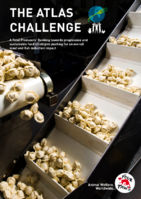
Food Producers
Are they addressing the impact of factory farming?
It is no secret that consumers are demanding greater transparency regarding animal welfare, environmental and health implications of the food they buy, requiring companies to step up their sustainability efforts. FOUR PAWS conducted a ranking on selected global leading food producers, focusing on ready meals*, and found that while some companies are implementing the increase of plant-based foods, their efforts towards meat and dairy reduction are insufficient. To drive impactful change, food producers must integrate their meat and dairy reduction targets into their long-term strategies, making firm commitments towards animal welfare and climate mitigation goals to help end factory farming.
This ranking is the ninth edition of the Atlas Challenge ranking series and is based on FOUR PAWS’ assessment (between July and November 2024). It provides a clear understanding of the eleven targeted food producers’ performance and strategy, focusing on three different categories:
- Meat and dairy reduction and climate goals
- Animal Welfare
- Plant-based food increase.
The below ranking shows the targeted food producers of ready meals and how they compared to each other:
A reduction in meat and dairy production and consumption along with an increase in plant-based foods, would not only lower the numbers of farmed animals in factory farms, and thus reduce animal suffering, but also dramatically decrease negative environmental impacts from the food industry.
For an overview of the criteria and scoring methodology, please click here.

The FOUR PAWS Food Producer Challenge: Ready Meals
A ranking of the leading food producers’ strategies for meat and dairy reduction towards animal welfare and climate mitigation
* The latest ranking compares producers of frozen, chilled or canned ready-to-eat meals and soups in a pre-cooked form that require little to no cooking or other preparation like frozen dinners, pizzas or stews. FOUR PAWS excluded instant ready meals such as packet soups and cup noodles as their content of meat and dairy is comparably low. Food on the go like sandwiches and wraps are not included either. Fresh cut salad, frozen vegetables and cut fruit are not part of the ready meal portfolio in general.
Did you know?
- The convenience food segment accounts for around 7.15% of the global food market, corresponding to retail sales of around EUR 533 billion in 2022 and is expected to grow to EUR 842 billion by 20291.
- Global production of meat, fish from aquaculture, eggs and dairy accounts for 57% of various food-related emissions2.
- Vegan ready meals have a market share of over 40% already3.
- Protein-rich foods account for the bulk of our dietary emissions. In European diets, meat, dairy and eggs account for 83%4,5.
- FOUR PAWS Meat Exhaustion Day Report (ref. to Planetary Health Diet) concludes that most European countries must reduce their meat consumption by at least 70% to stay within a healthy range for humans and the planet6.
- Animal agriculture takes up 80% of agricultural land, particularly due to grazing cattle and cultivating animal feed, while only 20% of agricultural land is used for crops for human consumption and non-food crops (textiles, energy etc.)7.
Source
2. Poore J, Nemecek T. Reducing food’s environmental impacts through producers and consumers. Science. 2018;360(6392):987–992. https://doi.org/10.1126/science.aaq0216
3. Market.us. Ready Meals Market. 2024 Mar [accessed 2024 Dec 3]. https://market.us/report/ready-meals-market/
4. Sandström V et al. The role of trade in the greenhouse gas footprints of EU diets. Global Food Security. 2018;19:48–55. https://doi.org/10.1016/j.gfs.2018.08.007
5. Ritchie H, Roser M. Less meat is nearly always better than sustainable meat, to reduce your carbon footprint. Our World in Data. 2024 Mar 18 [accessed 2024 Dec 23]. https://ourworldindata.org/less-meat-or-sustainable-meat
6. FOUR PAWS. Meat Exhaustion Day. How meat is eating up the planet. 2024 spotlight on the USA. 2024 [accessed 2024 Dec 23]. https://media.4-paws.org/2/3/8/c/238c33f2b0035c8f5118ce98af32e35210cfe1c7/2024-02-29_Meat_Exhaustion_factsheet_USA.pdf
7. Ritchie H, Roser M. Half of the world’s habitable land is used for agriculture. Our World in Data. 2024 Feb 21 [accessed 2024 Dec 23]. https://ourworldindata.org/global-land-for-agriculture
 Please be careful! If you delete this page, consider that it could be used within an other language version.
Please be careful! If you delete this page, consider that it could be used within an other language version.












